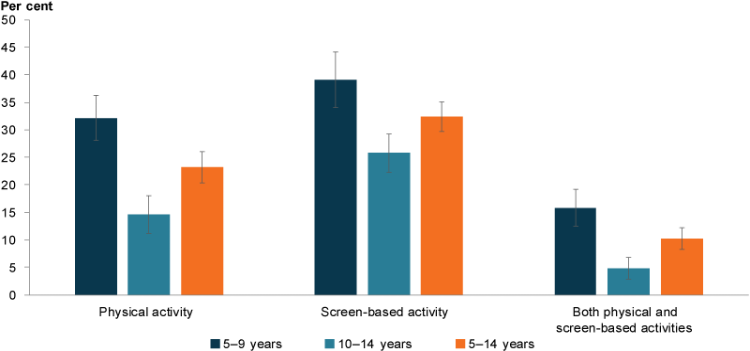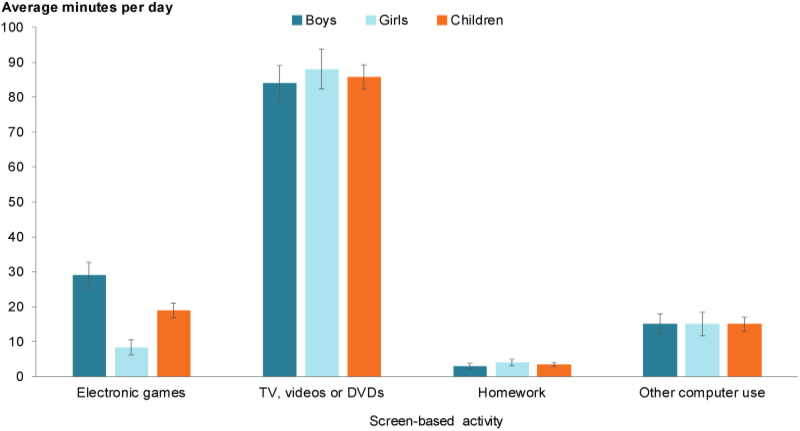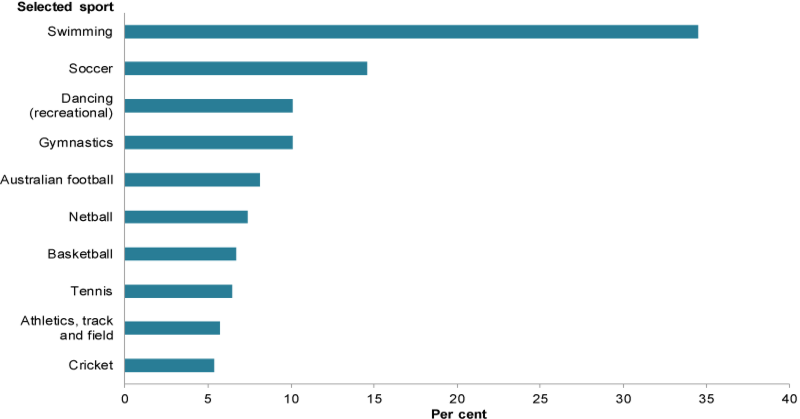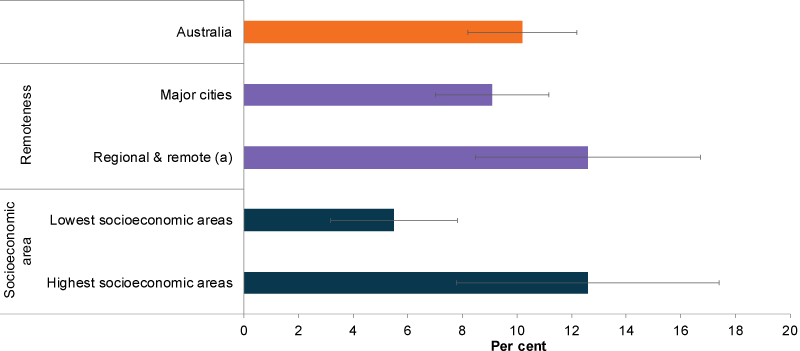Physical activity
Key findings
- In 2011–12, less than one-quarter (23%) of children aged 5–14 undertook the recommended 60 minutes of physical activity every day.
- On average, children aged 5–14 spent more than 2 hours (123 minutes) each day sitting or lying down for screen-based activities. Children aged 2–4 spent 83 minutes a day on average in front of screens.
- In 2018, two-thirds (67%) of children aged 0–14 participated in organised physical activities outside of school hours at least once a fortnight.
Participating in physical activity and limiting sedentary behaviour is central to a child’s health, development and psychosocial wellbeing. Regular activity supports brain development, bone strength, muscle control, balance and coordination, and helps to achieve and maintain a healthy weight. Being active can positively affect sleep patterns, mental health, concentration, self-esteem and confidence (DoH 2009, 2017a).
Participation in sufficient levels of physical activity is also important for cardiovascular, metabolic and musculoskeletal health, and plays a critical role in the prevention and treatment of non-communicable diseases such as heart disease, type 2 diabetes and some cancers (WHO 2010). Australia has developed Physical Activity and Sedentary Behaviour Guidelines which outline the amount of physical activity necessary for children and young people to obtain health benefits, and recommendations for reducing time spent in front of screens (DoH 2017a) (Box 1).
Box 1: How much physical activity is recommended?
The Australian Physical Activity and Sedentary Behaviour Guidelines differ depending on the age of children.
For children aged 2–4 who are not in school, the guidelines recommend:
- at least 180 minutes a day of physical activity, including energetic play
- no more than 60 minutes a day engaged in screen-based activity.
For children aged 5–12 and 13–17, the guidelines recommend:
- at least 60 minutes a day of moderate to vigorous intensity physical activity
- no more than 2 hours a day of screen-based activity for entertainment (for example, television, seated electronic games and computer use).
Sedentary behaviour is defined as sitting or lying down for activities (ABS 2014).
The most recent data available on physical activity in children at the time of publication come from the ABS National Nutrition and Physical Activity Survey 2011–12 (NNPAS), and the ABS Australian Aboriginal and Torres Strait Islander Health Survey: Physical Activity (AATSIHS) 2012–13. Children are reported as meeting the guidelines each day if they achieved the recommended levels of physical activity and/or screen time every day in the 7 days before being surveyed, with the exception of Indigenous data which reflects the 3 days before being surveyed (Box 2).
Box 2: Data sources on physical activity
ABS National Nutrition and Physical Activity Survey 2011–12
The ABS NNPAS 2011–12 was conducted as part of the Australian Health Survey 2011–12. It collected detailed information on children through interviews with an adult nominated by the household. Children are reported as meeting the guidelines each day if they achieved the recommended levels of physical activity and/or screen time every day in the 7 days before interview, with the exception of data for Indigenous children.
Data are reported for children aged 5–14 to align with the Children’s Headline Indicators Overweight and obesity indicator. Supplementary data are provided for children aged 2–4.
As the 2011–12 ABS National Nutrition and Physical Activity Survey data did not account for whether 5 year olds had started school, all 5 year olds were assessed using the guidelines for the 5–12 age group. In 2011, 82% of children aged 5 were in full-time schooling (ABS 2017).
ABS Australian Aboriginal and Torres Strait Islander Health Survey: Physical Activity 2012–13
Data for Indigenous children come from the ABS AATSIHS 2012–13. Comparison data for non-Indigenous children is from the NNPAS 2011–12.
Children are reported as meeting the guidelines each day if they achieved the recommended levels of physical activity and/or screen time every day in the 3 days before interview (ABS 2015).
Types of activities classified as physical activity in the AATSIHS and NNPAS include:
- outdoor activities such as individual or team sports, school physical education classes, brisk walking or running, helping in the garden, swimming, surfing, biking, rollerblading, and skateboarding.
- indoor activities such as dancing, ‘rough and tumble’ play, tidying up, helping to set the table and other active chores.
Data on children’s participation in organised sport and physical recreation come from the AusPlay survey, a national population tracking survey funded and led by the Australian Sports Commission. Data collection for AusPlay is continuous, with telephone interviews conducted every week and data aggregated over the year.
Data on children’s participation in cultural activities come from the ABS Multipurpose Household Survey . The survey is undertaken each financial year to collect statistics on a number of small, self-contained topics. In 2017–18, this included cultural participation.
How many children are doing enough physical activity?
According to self-reported data from the ABS NNPAS, in 2011–12:
- less than one-quarter (23%) of children aged 5–14 undertook the recommended 60 minutes of physical activity every day
- less than one-third (32%) met the screen-based activity guidelines
- only 1 in 10 (10%) children met both sets of guidelines each day (Figure 1).
Children aged 10–14 were less likely than those aged 5–9 to have met:
- physical activity guidelines (15% compared with 32%)
- screen-time guidelines (26% compared with 39%)
- both sets of guidelines (5% compared with 16%) (Figure 1).
On average, children aged 5–14 spent just over 2 hours (123 minutes) each day sitting or lying down for screen-based activities, with only 3.5 minutes of this being for homework (ABS 2013b).
Children aged 10–14 spent more time in front of screens (145 minutes a day, on average) than children aged 5–9 (102 minutes) (ABS 2013b).
Figure 1: Proportion of children aged 5–14 who met the physical and screen-based activity guidelines on all 7 days, by age group, 2011–12

Note: Met recommendations in the 7 days before interview.
Chart: AIHW. Source: ABS 2013a.
While there were no differences between the proportion of boys and girls aged 5–14 meeting the physical activity guidelines and both sets of guidelines, girls (38%) were more likely than boys (27%) to meet screen-time guidelines. On average, girls spent 115 minutes a day in front of screens, compared with 131 minutes for boys, with only 4 and 3 minutes of this being for homework (Figure 2) (ABS 2013b).
Nearly three-quarters (72%) of children aged 2–4 met the recommended 180 minutes of physical activity each day. However:
- just over one-quarter (26%) met the screen-based activity guideline
- only one-fifth (20%) met both physical and screen-based activity guidelines (ABS 2013b).
Boys and girls were equally as likely to meet each set of guidelines. On average, children aged 2–4 spent 83 minutes a day in front of screens (ABS 2013b).
Figure 2: Average minutes spent engaged in screen-based activities, children aged 5–14, by type of activity and sex, 2011–12

Chart: AIHW. Source: ABS 2013b.
Box 3: Screen time and children
Consistent with results from the NNPAS, a smaller, more recent national survey found 40% of primary school-aged children and 15% of teenagers met the screen-based activity guidelines in 2017 (Rhodes 2017).
The survey also found that nearly half (43%) of children regularly used screens at bedtime, and more than one-quarter (26%) reported having problems sleeping relating to their screen use (Rhodes 2017).
What types of physical activity are children doing?
The 2018 AusPlay survey estimated participation in organised physical activities outside of school hours at least once a week for:
- 65% (956,000) of children aged 5–8
- 78% (740,000) of children aged 9–11
- 72% (652,000) of children aged 12–14 (ASC 2019).
The most popular activity for children was swimming, with just under 1.7 million children aged 0–14 (34%) participating in organised swimming activities at least once in 2018. After swimming, the most popular organised activities for children were:
- football/soccer (700,000, or 15%)
- recreational dancing, (485,000, or 10%)
- gymnastics (484,000, or 10%)
- Australian rules football (390,000, or 8.1%) (ASC 2019) (Figure 2).
Figure 3: Top 10 most popular organised sport and leisure physical activities for children aged 0–14, 2018

Notes
- Data was collected through the child’s parent or guardian and relate to organised out-of-school sports and activities. Athletics and track and field include jogging and running.
- Data based on participation in activities at least once a year.
Chart: AIHW. Source: ASC 2019.
Box 4: Participation in cultural activities
Engaging in cultural activities, such as creative activities and reading for pleasure, are important for children’s health and wellbeing.
Participation in creative activities can improve children’s self-confidence, self-esteem, resilience, and pro-social behaviour, while recreational reading has been shown to improve imagination, focus, relaxation and mood regulation and increase social interactions (Bungay et al. 2013; Zarobe et al. 2017).
According to self-reported data from the 2017–18 ABS Multipurpose Household Survey, nearly two-thirds (63%) of children aged 5–14 participated in 1 or more creative activities outside of school hours, such as:
- drama
- singing
- playing a musical instrument
- dancing
- art and craft
- creative writing
- creating digital content.
Nearly 8 in 10 (79%) children aged 5–14 read for pleasure outside of school hours (ABS 2019).
Do physical activity levels vary by population group?
In 2011–12, children living in Major cities (20%) were less likely to have met the physical activity guidelines than children living in other areas (30%). However, children in Major cities (32%) were similarly likely to have met the screen-based activity guidelines as those in other areas (33%), and to have met both sets of physical and screen-based activity guidelines (9.1% and 13%, respectively).
Children in the lowest and highest socioeconomic areas met the physical activity guidelines at similar rates (24% and 25%, respectively). However, children living in areas of lower socioeconomic disadvantage were more than twice as likely to have met both sets of guidelines as those living in areas of greater disadvantage (13% compared with 5.5%, respectively) (Figure 3).
In 2012–13, while Indigenous children and non-Indigenous children aged 5–14 were equally as likely to have met the screen-time guidelines, Indigenous children were more likely to have met the physical activity guidelines (54% compared with 41%, respectively) and both sets of guidelines (29% compared with 22%, respectively) (Box 2).
Figure 4: Children aged 5–14 who met both physical and screen-based activity recommendations, by selected population groups, 2011–12

(a) Regional & remote includes Inner regional, Outer regional and Remote areas.
Note: Met recommendations each day in the 7 days before interview.
Chart: AIHW. Source: ABS 2013a.
Data limitations and development opportunities
In 2017, the Australian Government reviewed the Australian physical activity guidelines for children aged 0–5 to incorporate a 24-hour movement approach following Canadian guidelines (DoH 2017b). This approach emphasises the integration of all movement behaviours during the day, including physical activity, sedentary behaviour and sleep. However, there is currently no national data to show how children aged 0–5 are faring in line with these guidelines.
There are no consistent data available to monitor long-term trends in physical activity in children, as surveys that collect comprehensive data on time spent engaging in physical and sedentary activity are conducted infrequently. The most recent physical activity data for children come from the ABS National Nutrition and Physical Activity Survey 2011–12 and no trend data are currently available. However, under the Intergenerational Health and Mental Health Study, the ABS National Nutrition and Physical Activity Survey is scheduled to be conducted again in 2023.
Where do I find more information?
For information on:
- physical activity levels among different age groups, see: Physical activity across the life stages and Australia’s Health 2018, Insufficient physical activity.
- physical activity levels among young people aged 15–24, see: Level of physical activity in the National Youth Information Framework indicators.
ABS (Australian Bureau of Statistics) 2013a. Australian Health Survey: nutrition and physical activity, 2011–12. ABS cat. no. 4324.0.55.002. Canberra: ABS. Customised report.
ABS 2013b. Microdata: Australian Health Survey: nutrition and physical activity, 2011–12. ABS cat. no. 4324.0.55.002. Findings based on TableBuilder analysis. Canberra: ABS.
ABS 2014. Australian Health Survey: nutrition first results: foods and nutrients, 2011–12. ABS cat. no. 4364.0.55.007. Canberra: ABS.
ABS 2017. Schools, Australia, 2017. ABS cat. no. 4221.0. Canberra: ABS.
ABS 2019. Participation in selected cultural activities, Australia, 2017–18. ABS cat. no. 4921.0. Canberra: ABS.
ASC (Australian Sports Commission) 2019. AusPlay National data tables—January 2018 to December 2018 data. Canberra: ASC. Viewed 30 April 2019.
Bungay H & Vella-Burrows TK 2013. The effects of participating in creative activities on the health and well-being of children and young people: a rapid review of the literature. Perspectives in Public Health 133(1):44–52.
DoH (Department of Health) 2009. Get up & grow: healthy eating and physical activity for early childhood—directors/coordinators book. Canberra: DoH. Viewed 18 March 2019.
DoH 2017a. Australia’s Physical Activity and Sedentary Behaviour Guidelines. Canberra: DoH. Viewed 13 March 2019.
DoH 2017b. Physical activity and sedentary behaviour: research and statistics. Canberra: DoH. Viewed 13 March 2019.
Rhodes A 2017. Screen time and kids: what’s happening in our homes? Poll 7, June 2017. Melbourne: Royal Children’s Hospital Melbourne. Viewed 10 May 2019.
WHO (World Health Organization) 2010. Global recommendations on physical activity for health. Geneva: WHO. Viewed 18 March 2019.
Zarobe L & Bungay H 2017. The role of arts activities in developing resilience and mental wellbeing in children and young people a rapid review of the literature. Perspectives in Public Health 137(6):175791391771228.
ABS National Nutrition and Physical Activity Survey, 2011–12
- Proportion of all children meeting the physical activity and screen-based activity guidelines is those who met the recommendation in the 7 days prior to interview.
- Urban and rural areas in all states and territories were included, while Very Remote areas of Australia and discrete Aboriginal and Torres Strait Islander communities (and the remainder of the Collection Districts in which these communities were located) were excluded. These exclusions are unlikely to affect national estimates, and will only have a minor effect on aggregate estimates produced for individual states and territories, excepting the Northern Territory where the population living in Very Remote areas accounts for around 23% of persons.
- ‘Other areas’ includes Inner regional, Outer regional and Remote areas.
- Total of all children meeting and not meeting the guidelines includes ‘not known’.
- Total of time spent on sedentary screen-based activities excludes time not known.
- For technical information on the NNPAS, see Explanatory Notes.
- For information on data quality, see National Nutrition and Physical Activity Survey, 2011–12 Quality Declaration.
ABS Australian Aboriginal and Torres Strait Islander Health Survey (AATSIHS), 2012–13
- Proportion of Indigenous and non-Indigenous children meeting the physical activity and screen-based activity guidelines is those who met the recommendation in the 3 days prior to interview.
- For technical information on the AATSIHS 2012–13, see Explanatory Notes.
- For information on data quality, see Australian Aboriginal and Torres Strait Islander Health Survey, Nutrition and Physical Activity, 2012–13 Quality Declaration.
The AusPlay Survey
- AusPlay data for children 0–14 years was collected via the child’s parent/guardian for organised participation outside of school hours.
- Data collection for AusPlay is continuous, with telephone (landline and mobile) interviews conducted every week and data aggregated over the year. All Australian residents are in scope of the survey.
- For technical information on AusPlay, see Methodology.
ABS Multipurpose Household Survey, 2017–18
- Data on participation in selected cultural activities from the Multipurpose Household Survey only includes activities outside of school hours. Participation in creative activities includes drama activities, singing, playing a musical instrument, dancing, art and craft, creative writing and creating digital content. Excludes participation in screen based activities and reading for pleasure.
- For technical information on the ABS Multipurpose Household Survey 2017–18, see Explanatory Notes.
- For information on data quality, see Participation in Selected Cultural Activities, Australia, 2017–18 Quality Declaration: Summary.
For more information, see Methods.


